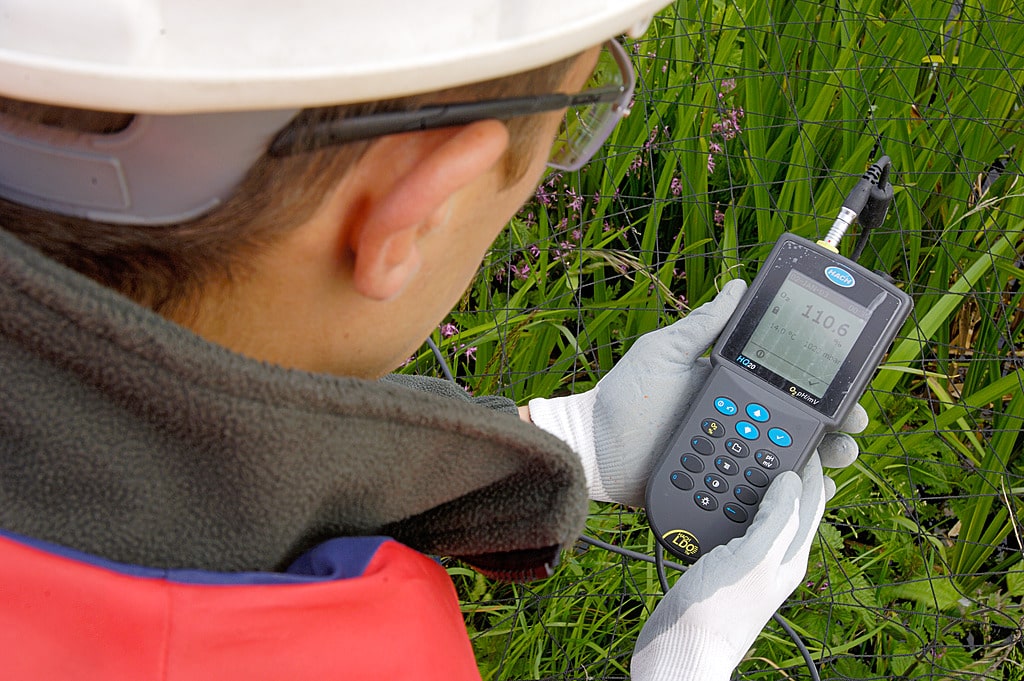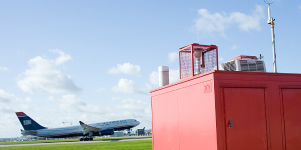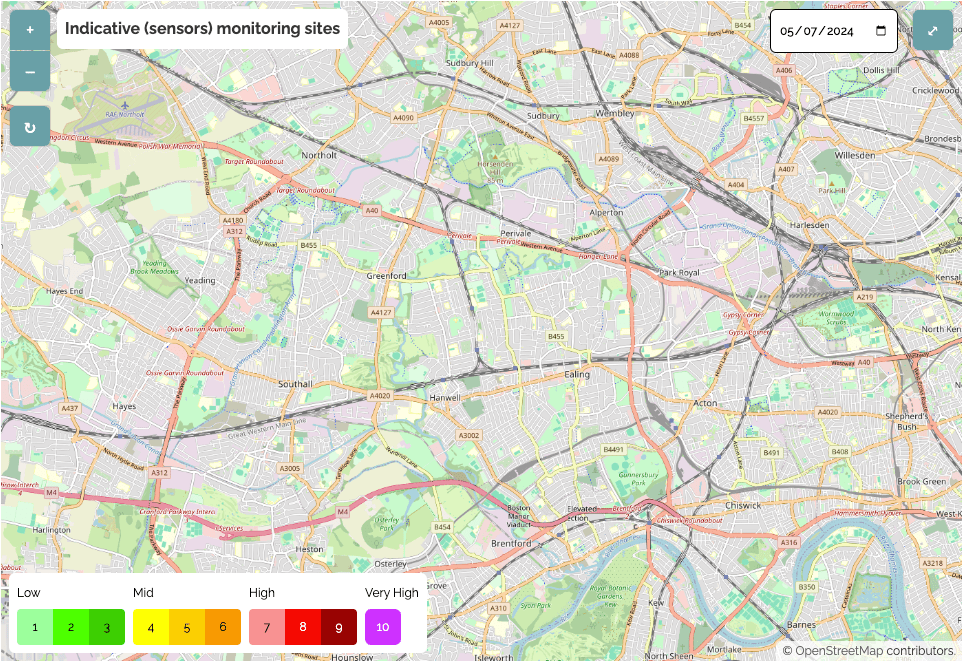Air quality Heathrow
Air quality information for the Heathrow area. Providing you with air quality information in real time; on how Heathrow is helping to make it better; and pollution alerts if levels exceed government guidelines.
The latest air quality information for the Heathrow area
We have three types of air quality information for the Heathrow area, click on the markers on the map to find out more about what it means to you.
Find out about the different types of information using the links below the map.
Forecast for
Heathrow
Air pollution levels are forecast to be mainly Low with a slight possibility of Moderate today
Air pollution levels are expected to be Moderate tomorrow
Air pollution levels are expected to be Moderate beyond tomorrow
Last updated: 4:00 AM on Sat 26th April 2025
Our three types of air quality information
Monitoring data
Real-time data collected by Ricardo from monitoring sites in the Heathrow Airwatch monitoring area.
Forecast data
Air quality forecast information created from a combination of Defra pollution data and Met Office weather forecasts.
Modelled data
Defra's air quality modelling showing meteorological simulations for the Heathrow area.
How is air quality measured?
Air quality in the four local authorities surrounding Heathrow is measured independently by Ricardo and presented using the Daily Air Quality Index (DAQI).
The DAQI is numbered 1-10 and divided into four bands, low (1) to very high (10), to provide detail about air pollution levels in a simple way. This system was recommended by the Committee on Medical Effects of Air Pollutants (COMEAP) and is applied to monitoring data by Ricardo.
Select each band below to see what they mean for you.
Air Pollution banding Low (1 - 3)
Accompanying health messages for at-risk individuals*
Enjoy your usual outdoor activities.
Accompanying health messages for the general population
Enjoy your usual outdoor activities.
* It is important to note children and adults with pre-existing health conditions are at greater risk of health symptoms caused by air pollution. It is possible that very sensitive individuals may experience health effects even on Low air pollution days.
Air Pollution banding Moderate (4 - 6)
Accompanying health messages for at-risk individuals*
Adults and children with lung problems, and adults with heart problems, who experience symptoms, should consider reducing strenuous physical activity, particularly outdoors.
Accompanying health messages for the general population
Enjoy your usual outdoor activities.
* It is important to note children and adults with pre-existing health conditions are at greater risk of health symptoms caused by air pollution. It is possible that very sensitive individuals may experience health effects even on Low air pollution days.
Air Pollution banding High (7 - 9)
Accompanying health messages for at-risk individuals*
Adults and children with lung problems, and adults with heart problems, should reduce strenuous physical exertion, particularly outdoors, and particularly if they experience symptoms. People with asthma may find they need to use their reliever inhaler more often. Older people should also reduce physical exertion.
Accompanying health messages for the general population
Anyone experiencing discomfort such as sore eyes, cough or sore throat should consider reducing activity, particularly outdoors.
* It is important to note children and adults with pre-existing health conditions are at greater risk of health symptoms caused by air pollution. It is possible that very sensitive individuals may experience health effects even on Low air pollution days.
Air Pollution banding Very High (10)
Accompanying health messages for at-risk individuals*
Adults and children with lung problems, adults with heart problems, and older people, should avoid strenuous physical activity. People with asthma may find they need to use their reliever inhaler more often.
Accompanying health messages for the general population
Reduce physical exertion, particularly outdoors, especially if you experience symptoms such as cough or sore throat.
* It is important to note children and adults with pre-existing health conditions are at greater risk of health symptoms caused by air pollution. It is possible that very sensitive individuals may experience health effects even on Low air pollution days.

Measured Air Pollutants
The below pollutants are measured in the Heathrow area. Select each one to find out more about them and where they typically come from.
Nitrogen dioxide (NO2) is a gas that is mainly produced during the combustion of fossil fuels (Aviation and road traffic being significant sources around Heathrow), along with nitric oxide (NO).
Nitrogen dioxide can irritate the lungs and lower resistance to respiratory infections such as influenza.
Continued or frequent exposure to concentrations that are typically much higher than those normally found in the ambient air may cause increased incidence of acute respiratory illness in children.
Fine Particles are composed of a wide range of materials arising from a variety of sources including:
- Combustion sources (mainly road traffic),
- Secondary particles, mainly sulphate and nitrate formed by chemical reactions in the atmosphere, and often transported from far across Europe, and
- Coarse particles, suspended soils and dusts (e.g., from the Sahara), sea salt, biological particles, and particles from construction work.
Particles are measured in several different size fractions according to their mean aerodynamic diameter. Most monitoring is currently focussed on PM10, but the finer fractions such as PM2.5 and PM1 are becoming of increasing interest in terms of health effects.
Fine particles can be carried deep into the lungs where they can cause inflammation and a worsening of the condition of people with heart and lung diseases. In addition, they may carry surface-absorbed carcinogenic compounds into the lungs.
Ozone (O3) is not emitted directly from any human-caused source in any significant quantities. In the lower atmosphere, O3 is primarily formed by a complicated series of chemical reactions started by sunlight. These reactions can be summarised as the sunlight-initiated oxidation of volatile organic compounds (VOCs) in the presence of nitrogen oxides (NOx).
The chemical reactions do not take place instantaneously, but can take hours or days, therefore ozone measured at a particular location may have arisen from VOC and NOx emissions many hundreds or even thousands of miles away. Maximum concentrations, therefore, occur downwind of the source areas of the precursor pollutant emissions.
Ozone irritates the airways of the lungs, increasing the symptoms of those suffering from asthma and lung diseases.
Common sources of VOCs include:
- Solvent use, and
- Petrol distrubution and handling
Nitric oxide (NO) is not considered to be harmful to health. However, once released to the atmosphere, NO is usually very rapidly oxidised to nitrogen dioxide (NO2), which is harmful to health.
NO2 and NO are both oxides of nitrogen and together are referred to as nitrogen oxides (NOx).
Common sources of NO include:
- Road transport emissions, and
- other combustion processes such as the electricity supply industry.
Ultrafine particles (UFPs) are tiny particles smaller than fine particles like PM10, PM2.5, and PM1. UFPs are less than 0.1 micron in size, which is much smaller than a human hair.
Because they are so tiny, their weight is usually not measured; instead, the number of UFPs in the air is counted.
There are no national regulations for UFPs at this time, but the World Health Organization (WHO) has given guidelines on safe and dangerous levels of these particles.
Common sources of UFPs include:
- - Aviation, combustion, road traffic (including tire and brake wear), biomass burning, and industrial processes.
-
- Natural events like volcanic eruptions, ocean spray, and wildfires.
-
UFPs are different from larger fine particles because they can travel deep into the lungs, enter the bloodstream, and spread to other parts of the body.
This ability makes UFPs potentially more harmful to health.
Nitrogen dioxide (NO2) is a gas that is mainly produced during the combustion of fossil fuels (Aviation and road traffic being significant sources around Heathrow), along with nitric oxide (NO).
Nitrogen dioxide can irritate the lungs and lower resistance to respiratory infections such as influenza.
Continued or frequent exposure to concentrations that are typically much higher than those normally found in the ambient air may cause increased incidence of acute respiratory illness in children.
Fine Particles are composed of a wide range of materials arising from a variety of sources including:
- Combustion sources (mainly road traffic),
- Secondary particles, mainly sulphate and nitrate formed by chemical reactions in the atmosphere, and often transported from far across Europe, and
- Coarse particles, suspended soils and dusts (e.g., from the Sahara), sea salt, biological particles, and particles from construction work.
Particles are measured in several different size fractions according to their mean aerodynamic diameter. Most monitoring is currently focussed on PM10, but the finer fractions such as PM2.5 and PM1 are becoming of increasing interest in terms of health effects.
Fine particles can be carried deep into the lungs where they can cause inflammation and a worsening of the condition of people with heart and lung diseases. In addition, they may carry surface-absorbed carcinogenic compounds into the lungs.
Ozone (O3) is not emitted directly from any human-caused source in any significant quantities. In the lower atmosphere, O3 is primarily formed by a complicated series of chemical reactions started by sunlight. These reactions can be summarised as the sunlight-initiated oxidation of volatile organic compounds (VOCs) in the presence of nitrogen oxides (NOx).
The chemical reactions do not take place instantaneously, but can take hours or days, therefore ozone measured at a particular location may have arisen from VOC and NOx emissions many hundreds or even thousands of miles away. Maximum concentrations, therefore, occur downwind of the source areas of the precursor pollutant emissions.
Ozone irritates the airways of the lungs, increasing the symptoms of those suffering from asthma and lung diseases.
Common sources of VOCs include:
- Solvent use, and
- Petrol distrubution and handling
Nitric oxide (NO) is not considered to be harmful to health. However, once released to the atmosphere, NO is usually very rapidly oxidised to nitrogen dioxide (NO2), which is harmful to health.
NO2 and NO are both oxides of nitrogen and together are referred to as nitrogen oxides (NOx).
Common sources of NO include:
- Road transport emissions, and
- other combustion processes such as the electricity supply industry.
Ultrafine particles (UFPs) are tiny particles smaller than fine particles like PM10, PM2.5, and PM1. UFPs are less than 0.1 micron in size, which is much smaller than a human hair.
Because they are so tiny, their weight is usually not measured; instead, the number of UFPs in the air is counted.
There are no national regulations for UFPs at this time, but the World Health Organization (WHO) has given guidelines on safe and dangerous levels of these particles.
Common sources of UFPs include:
- - Aviation, combustion, road traffic (including tire and brake wear), biomass burning, and industrial processes.
-
- Natural events like volcanic eruptions, ocean spray, and wildfires.
-
UFPs are different from larger fine particles because they can travel deep into the lungs, enter the bloodstream, and spread to other parts of the body.
This ability makes UFPs potentially more harmful to health.
Ozone (O3) is not emitted directly from any human-caused source in any significant quantities. In the lower atmosphere, O3 is primarily formed by a complicated series of chemical reactions started by sunlight. These reactions can be summarised as the sunlight-initiated oxidation of volatile organic compounds (VOCs) in the presence of nitrogen oxides (NOx).
The chemical reactions do not take place instantaneously, but can take hours or days, therefore ozone measured at a particular location may have arisen from VOC and NOx emissions many hundreds or even thousands of miles away. Maximum concentrations, therefore, occur downwind of the source areas of the precursor pollutant emissions.
Ozone irritates the airways of the lungs, increasing the symptoms of those suffering from asthma and lung diseases.
Common sources of VOCs include:
- Solvent use, and
- Petrol distrubution and handling
Nitric oxide (NO) is not considered to be harmful to health. However, once released to the atmosphere, NO is usually very rapidly oxidised to nitrogen dioxide (NO2), which is harmful to health.
NO2 and NO are both oxides of nitrogen and together are referred to as nitrogen oxides (NOx).
Common sources of NO include:
- Road transport emissions, and
- other combustion processes such as the electricity supply industry.
Ultrafine particles (UFPs) are tiny particles smaller than fine particles like PM10, PM2.5, and PM1. UFPs are less than 0.1 micron in size, which is much smaller than a human hair.
Because they are so tiny, their weight is usually not measured; instead, the number of UFPs in the air is counted.
There are no national regulations for UFPs at this time, but the World Health Organization (WHO) has given guidelines on safe and dangerous levels of these particles.
Common sources of UFPs include:
- - Aviation, combustion, road traffic (including tire and brake wear), biomass burning, and industrial processes.
-
- Natural events like volcanic eruptions, ocean spray, and wildfires.
-
UFPs are different from larger fine particles because they can travel deep into the lungs, enter the bloodstream, and spread to other parts of the body.
This ability makes UFPs potentially more harmful to health.
Ultrafine particles (UFPs) are tiny particles smaller than fine particles like PM10, PM2.5, and PM1. UFPs are less than 0.1 micron in size, which is much smaller than a human hair.
Because they are so tiny, their weight is usually not measured; instead, the number of UFPs in the air is counted.
There are no national regulations for UFPs at this time, but the World Health Organization (WHO) has given guidelines on safe and dangerous levels of these particles.
Common sources of UFPs include:
- - Aviation, combustion, road traffic (including tire and brake wear), biomass burning, and industrial processes.
-
- Natural events like volcanic eruptions, ocean spray, and wildfires.
-
UFPs are different from larger fine particles because they can travel deep into the lungs, enter the bloodstream, and spread to other parts of the body.
This ability makes UFPs potentially more harmful to health.
What is Heathrow doing to improve air quality?
Heathrow is working hard to improve the air quality in the local area with the following initiatives.
Reduce emissions from HAL

Increasing low emission fleet vehicles
27% of Heathrow Airport’s own fleet of around 200 vehicles is now electric, with a further 20% Hybrid.

Decarbonising heating supply
To deliver an emission reduction via efficiency and seeking alternative solutions to energy generation.

Progress Air Quality Research
Maintain active support for ongoing research and monitoring initiatives regarding ultrafine particulate matter, facilitating advancements in knowledge development and fostering shared experiences among various airports.
Reduce emissions airside

Incentivising use of Sustainable Aviation Fuels
In 2022, Heathrow introduced a Sustainable Aviation Fuel incentive programme, which incentivises the use an airplane fuel alternative designed to cut carbon emissions.

Reducing grounded engine use
Heathrow are now supplying power and air conditioning from terminals to reduce use of Auxiliary Power Units and Ground Power Units.
They have also redesigned taxiways so that aircraft can travel more directly to stands reducing the use of engines on the ground.

Incentivising airlines to use cleaner planes
Since introducing NOx landing charges in 2004, and subsequent increases in our NOx charges, Heathrow has one of the strongest systems globally, airlines have been incentivised to bring cleaner aircraft to Heathrow and our data shows that these incentives are working.
Improve air quality in the local community

Improving Public Transport
Major investments are being made in the public transport infrastructure servicing Heathrow Airport.

Improving Cycling and walking to work networks
Heathrow are working with neighbouring Local Authorities to connect and build out a cycling network. This is set out in the Heathrow Local Cycling and Walking Infrastructure Plan, published in April 2023

Continued investment in the Sustainable Travel Zone
In 2022 Heathrow announced the launch of its Sustainable Travel Zone, a network of subsidised travel routes to and from the airport to make it more.

